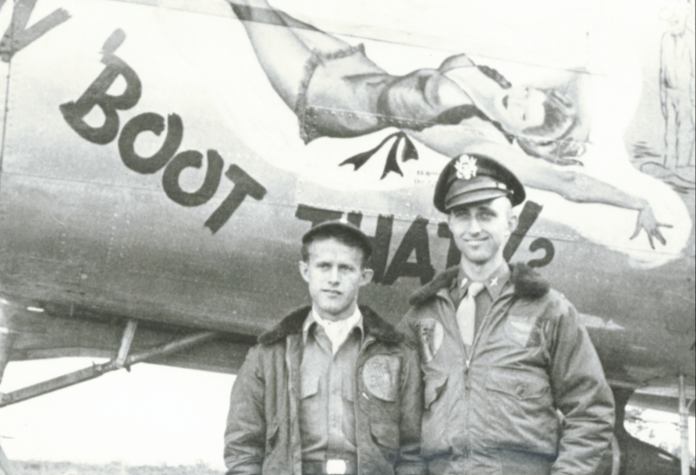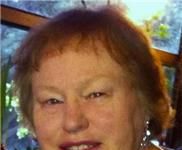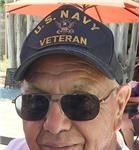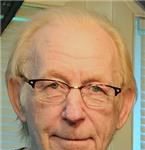Before he became a dentist and before he met the sweetheart of his life, Harry Burmester fell in love with flying airplanes.
He flew his private Beechcraft with his wife, kids and friends all over the U.S. and to Canada and Mexico, golfing, water skiing, swimming, just enjoying the heck out of life.
He’d seen enough death and destruction.
The World War II bomber pilot, who at age 23 flew an astonishing 70-plus missions and earned the Distinguished Flying Cross, died on Saturday, Dec. 3. The long-time Gilroy resident and popular dentist would have turned 96 on January 18, 2017.
“He was one of the most honest, caring people I have ever met; he cared about people and he cared about the world’s problems,” said Dottie Burmester, 75, his wife of 43 years.
“He was smart and he was a gentleman, different from all the other guys. There was something about him that caught my attention,” she said of the day they met in September 1970.
An insurance underwriter, she moved to Gilroy a short time later and they married in September 1972.
Dr. Burmester practiced for a while in Hollister before moving his office to Gilroy. He retained many of his San Benito County clients and also became one of the original owner-builders of the Gilroy Medical Park on Wren Avenue.
Burmester had two sons and a daughter—Cliff, Jeff and Krisi—from his first marriage, helped raise Dottie’s daughter from her first marriage, Katrina, and the couple were like second parents to Deanna Wilson Fernandez, the daughter of friends.
“He was the kindest, most loving man I have ever met; if there were more men like him the world would be a better place, he was like a father to me, said Fernandez, 54, of Elk Grove.
“He was a great role model,” said son Jeff Burmester, 65, of Twain Harte. “I remember when I was little all the kids were asking what my father did in World War II; when I asked him if he had killed anybody, he said, ‘I sure hope not.’”
His father was born Harry Clifton Burmester in San Jose in 1921 and grew up on 18th Street. The son of a baker who’d immigrated as a youth from Germany and an American mother who was a nurse, Burmester joined the Army Air Corps from high school and began training in December 1942. He kept a diary while in the service.
With a flight instructor, he flew for the first time on April 19, 1943 and wrote: “Heaved my cookies after 20 minutes.” He would get sick on his next two flights.
After his fourth lesson with an instructor he wrote, “Was beautiful day and really enjoyed myself. Didn’t get sick.”
And on May 19 there was this: “I soloed. Went around twice. Was greatest thrill that I’ve ever experienced.”
By August 1944 he was in combat, piloting a B25 Mitchell bomber out of Corsica, hitting bridges, rail lines and other strategic targets.
The life expectancy of a bomber and its typically 10-man crew was measured in weeks in those days and Burmester’s plane, How ‘Boot That! had its share of close calls and miracles.
On Sept. 14, 1944, he wrote, “On today’s mission a frag bomb from one of our ships fell through dome of Pilot’s compartment and landed on Co-Pilot’s lap without exploding. The Co-Pilot was dazed, got up and put bomb in seat and bailed out. Engineer threw the bomb out.”
By April 1945 he had been promoted from 1st Lt. to Captain and was stationed at Fano, Italy; the allies were hitting the enemy with continued massive bombing campaigns.
From his journal entry April 9: “Was coordinated attack with 1,000 fighter bombers, 800 heavies plus all the mediums that could be put up. Target area was just over the lines Northwest of Faenza. Took 14 minutes from field to target.”
Eight days later he returned from his 70th mission, which meant he could go home. But he piloted at least one more mission, dropping supplies to allied prisoners of war just liberated by American troops.
Of surviving more than 70 missions, he would later tell a friend, humbly, it was only because the Germans were more interested in shooting down B17s than B25s.
Dottie Burmester said her husband had wanted to continue flying after the war but so did lots of other ex-military pilots, so he used the GI Bill for college and dental school at UCSF, Class of ‘52.
To a person, friends and family said Burmester was a kind and quiet man who loved big band music and good food but never discussed the war, the few exceptions only when it was dragged out of him. His DFC award hung in an obscure part of his dental office.
“We’d been married a long time before I found it,” Dottie Burmester said. “I was impressed; here I was living with a piece of history. I was flabbergasted by the number of missions, that he was never shot down and he never lost a member of his squad,” she said.
She began to learn more about his service record when Burmester was contacted in the mid-1990s by a man who was restoring the B25 Burmester flew in the war.
They’d even found the artist who’d painted the original nose art—a scantily clad pinup gal—and had him do it again.
Burmester and his wife were invited to Texas to be part of a flight to the famous Oshkosh Air Show in Wisconsin.
Around 75 at the time, Burmester sat in the co-pilot’s seat, where the dud frag bomb had landed nearly a half-century earlier, while Dottie Burmester was in a P51 chase plane taking photos.
The restored B25 and Burmester’s journals and flight suit are now in the Cavanaugh Flight Museum in Addison, Texas.
“Everybody loved him very, very dearly, he was a great guy to know,” said longtime friend, Phil Buchanan of Gilroy, also a dentist.
“He was a hell of a good dentist and a hell of a good man, and he was an uncanny expert at flying. He was a hero’s hero and he never talked about it,” he said.
Burmester was nearly 80 before he gave up flying, but he continued to play golf and tennis well into his 90s and was still doing 100 sit-ups a day into his 80s, and even beat his two sons in a golf match last year, according to Jeff Burmester.
“He was a very active man, the last few months really dragged on him,” Dottie Burmester said, adding he’d had a pacemaker installed five years ago and had fought off several bouts of pneumonia before he succumbed at Kaiser in Santa Clara, she said.
“If you didn’t know anything about Harry, you’d think he went to school and became a dentist and had a nice, easy life, but he was (in the war) and he had done all that stuff, but you’d never know it,” said JB Howard of Carmel Valley, another long time friend.
They’d flow to the Delta for water skiing every year for decades, ditto for flights to Mexico, he said.
“Harry was a very special person, very gracious and very humble,” he said, compared to some of the “hell raisers” he called friends, according to Howard.
“Harry never drank and never smoked; he was just probably one of the finest individuals you ever want to meet, a prince of a guy who never complained. You couldn’t ask for a better person,” he said, recalling his friend’s trademark speedo bathing suit and old fisherman’s hat.
He recalled one flight when the runway lights at the Hollister airport did not come on when Harry pressed the remote control.
“He just said, “That’s great, I always wanted to land at this airport in the dark,’” according to Howard, who teared up while talking about his old pal.
Said Dottie Burmester, “We did a lot of things, we traveled, we had a really good life.”













